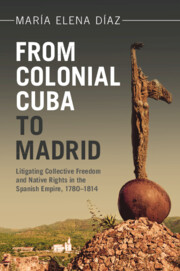 From Colonial Cuba to Madrid
From Colonial Cuba to Madrid Published online by Cambridge University Press: 14 November 2024
Based on discursive analysis, Chapter 3 focuses on the briefs produced in Madrid and the colony to mount the plaintiffs’ case for collective freedom. It examines the meanings of freedom in the Spanish Atlantic and the battery of legal tools, including the rarified one of prescription, deployed in the plaintiffs’ memorials to buttress their case of wrongful enslavement and collective freedom. The case entered unchartered terrain with the claim that belonging to a pueblo constituted a way of enacting and producing freedom collectively, an innovative claim based on notions of corporate belonging in the Spanish Atlantic world especially related to municipal bodies such as pueblos. The chapter parses a distinction between civil and political freedom made in some briefs. Civil freedom was understood in opposition to slavery as personal freedoms that free subjects could enjoy as royal vassals even in the context of colonialism and royal absolutism. Political freedom depended on municipal belonging, the space in which limited self-rule and citizenship could be locally enacted in an absolute monarchy. The chapter draws out the possible normative implications of this claim for Afro descendants at large who, at most, could only enjoy civil freedom rights in the empire.
To save this book to your Kindle, first ensure [email protected] is added to your Approved Personal Document E-mail List under your Personal Document Settings on the Manage Your Content and Devices page of your Amazon account. Then enter the ‘name’ part of your Kindle email address below. Find out more about saving to your Kindle.
Note you can select to save to either the @free.kindle.com or @kindle.com variations. ‘@free.kindle.com’ emails are free but can only be saved to your device when it is connected to wi-fi. ‘@kindle.com’ emails can be delivered even when you are not connected to wi-fi, but note that service fees apply.
Find out more about the Kindle Personal Document Service.
To save content items to your account, please confirm that you agree to abide by our usage policies. If this is the first time you use this feature, you will be asked to authorise Cambridge Core to connect with your account. Find out more about saving content to Dropbox.
To save content items to your account, please confirm that you agree to abide by our usage policies. If this is the first time you use this feature, you will be asked to authorise Cambridge Core to connect with your account. Find out more about saving content to Google Drive.